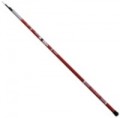Rod action
The action the rod matches. This parameter is often associated with spinning models (see “Type”), but it can also be indicated in other varieties.
The action characterizes the overall rigidity and elasticity of the rod blank - the main working part located between the handle and the upper end. In practice, the characteristics of bending and straightening during casting depend on this indicator. The
“faster” the action of the rod, the stiffer it is, the smaller part of it (counting from the upper end) bends when casting and the faster the structure returns to its original state. Conversely, a slow action means that the rod bends almost along its entire length and returns back at a relatively low speed.
If we talk about specific numbers, then models that bend 1/3 of the length or less are considered
fast, and models that bend 2/3 of the length or more are classified as
slow. Between these numbers there are intermediate indicators:
medium-fast,
medium and
medium-slow.
The progressive or complex system stands apart from others. The main feature of such rods is that when casting, they work as a fast-action rod, and when fishing for large prey, they exhibit the properties of a medium or even slow action, bending
...as the load increases in the shape of a parabola and at the same time dampening the jerks of the fish. Progressive rods combine the advantages of fast and slow blanks in one bottle, but they are more expensive than their traditional counterparts.
The choice of fishing rod depends primarily on the expected fishing conditions. Thus, fast models are well suited for situations where there is no space for a swing - they allow you to throw the bait quite far due to just one movement of the wrist. Such products are considered more accurate; with a fast rod it is easier to throw the bait into a “window” among the algae or other small place. In addition, the rigidity provides good sensitivity when retrieving and playing. In turn, a slow action requires space for the swing, but allows for greater casting distance and reduces the likelihood of line breakage during sudden jerks of prey. Well, we should also not forget about the personal preferences of the fisherman - after all, the effectiveness of casting largely depends on the overall convenience of the rod.Max. casting
The maximum weight of the entire rig (including bait, weights, hooks, etc.) that the rod can handle. This parameter is not recommended to be exceeded: the structure will be subjected to off-design loads and wear out a lot, to the point that the rod can simply break during a normal cast. In addition, the off-design weight of the casting significantly reduces the range and accuracy of the cast, which is critical, in particular, in spinning and match fishing (see "Rod type").
Min. casting
The minimum weight of equipment (lures, sinkers, hooks, floats, etc.) with which the rod will work effectively. Compliance with this parameter is important, first of all, for types of fishing that require high accuracy, for example, match or spinning (for more details, see "Rod Type") — a rig that is too light will not allow you to cast the rod far enough and accurately.
Sections
The number of sections provided in the design of the folding rod (see "Design"). Of two rods of the same length, a model with more sections will have a smaller length of each individual section and, accordingly, will be more compact and easier to transport. On the other hand, numerous sections adversely affects the overall strength of the structure. Therefore, when choosing, it is desirable to decide what is more important for you — ease of transportation or high strength.
Working length
The length of the rod in the unfolded (working) position. For different types of fishing, different lengths are considered optimal; see "Rod Type" for more on this. If the type of rod you need has numerous length variations, when choosing, you should take into account the conditions in which you have to fish. On the one hand, longer models usually have a greater casting distance (this is especially true for float fishing); on the other hand, for limited conditions (for example, with dense vegetation on the shore or when fishing from a boat), it may make sense to take a shorter rod.
Folded length
The length of the rod when folded. This parameter primarily affects the convenience of transportation: the shorter the folded rod, the easier it is to carry / transport.
